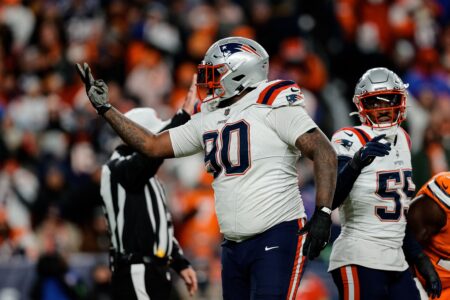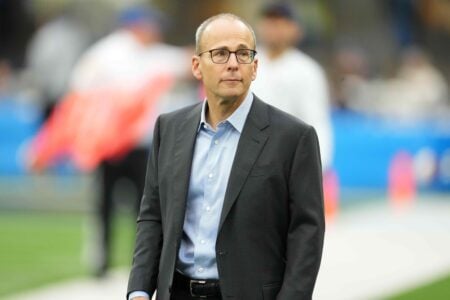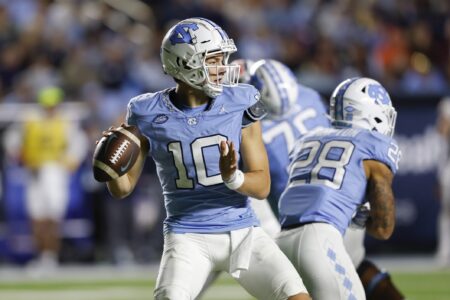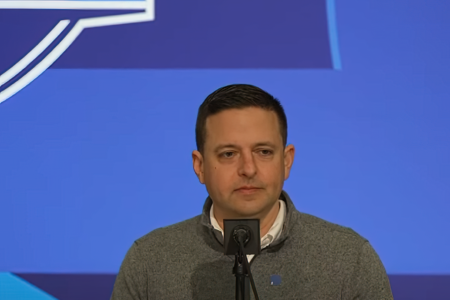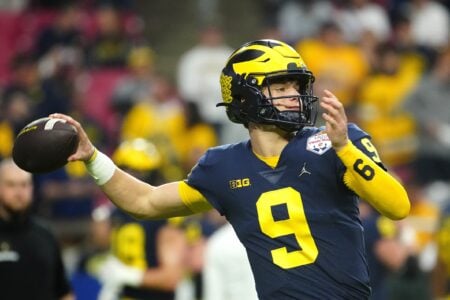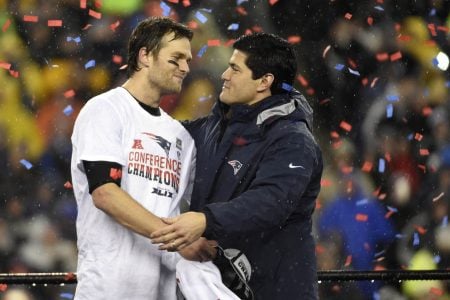- Joined
- Mar 13, 2005
- Messages
- 20,536
- Reaction score
- 1
It's time to once again bring forth this edifice to man and womankind's efforts to comprehend the mystical Belipioli drafting process. It's a bit tattered by time and new draft data, but an entertaining read and a symbol of rook's greatness as an amateur draft warrior. MM was the custodian, but by now several of us have it secreted away that it not die in DOS attacks, but remain safe for future generations. Enjoy!
Value Grouping
Value Grouping - by rookBoston
Submitted By: Mark Morse
April 20, 2004
Value Grouping Theory
This was a message by rookBoston who posts on the PatsFans Draft Forum Messageboard. I was so impressed with this post that I thought I would put it out here in the Draft section. I cannot take credit for this since it is someone else’s work, but I like the thinking behind it and I think you will find it interesting as well.
-------------------------------
I wanted to post something about "Value Grouping", which is the term I use to rationalize BB's draft day strategy. I posted something about this immediately after the 2003 draft.
That draft was incredible, but it left me totally confused. I couldn't see any logic in the trading up and down. The strategy seemed haphazard, and yet it produced very reliable results. It could not have been blind luck that they filled all their positions of need at ideal value spots in the draft. How did they do it?
I don’t know if this is something that is widely discussed in the Nation, or if it's just a pet theory of my own. I haven't read anything about it, or if I have, I've forgotten that I did. I think BB has probably explained the concept behind his draft strategy to the media, although Tom Curran's recent article makes no mention of this type of targeting. I’m not sure how explicit BB’s been in describing how it works.
I thought, I’d post my understanding of how the Pats approach the draft, because so far as I know it is clearly not an intuitive or typical strategy.
-------------------------------
Here’s how it works:
BB, SP and the scouting team identify a group of players who would provide roughly the same value for the team. It is absolutely critical that the staff “believes” in all the players in the value group, without exception. All of them have to be guys that the staff would feel good about drafting and would want to have on the team.
Once a player makes it into a value group, that means he is being targeted for the draft. Before the draft, the staff identify what their key needs are, and decide how they plan on filling those needs, using the value groupings they’ve defined. Generally speaking, it is possible to say, “this group of players should go in the early 1st round, this group of players should go in the late 2nd, early 3rd.”
On draft day, as the players in a targeted value group start coming off the board, the Pats lie in wait, patiently. The first players coming off the board for a given value group set the baseline value for that group. Once a value group is down to one or two players remaining, they trade into position to take the last guy in that group.
The downside is that by definition, you are taking the guy in each Value Group which the other teams think is the worst of the bunch. But if you’ve setup the board correctly, it shouldn’t matter. It is your own evaluation that counts, not the rest of the teams.
The upside is, you get good players for rock bottom prices. Most important, you eliminate (or at least dramatically reduce) the risk that you come away with absolutely nothing. Examples will help explain how this is possible, in practice.
----------------------------------
Examples #1 - Wilson
The clearest example of this strategy in action was the drafting of Eugene Wilson in 2003. Belichick had said that one of his offseason goals was to get younger and faster in the secondary. Clearly, that meant an early round selection at CB. No surprises.
At #19, there were a bunch of very good CBs available: Andre Woolfolk, Charles Tillman, Eugene Wilson, Sammy Davis, Nnamdi Asomugha. It’s hard for me to say which of these players were in the Pats draft board, but I would bet that Woolfolk, Tillman, Wilson and Davis were all in the same value grouping.
At 19, Belichick had his choice of any of them. It would not have been a reach to take Woolfolk at that point, according to the scouts. Since the draft, so far as I hear, Woolfolk has established himself as a solid young player in Tennessee. But, instead, Belichick traded down to #41 and watched as Woolfolk, Davis, Asomugha all came off the board in the first round. Then, at the top of the 2nd, as soon as Tillman comes off the board at #35, Belichick promptly trades back up to take Wilson at #36 (from #41).
Note: Give Mel Kiper his credit, he was the only one who had Wilson rated as a 1st round pick.
After Wilson, only one CB was taken in the draft over the next 46 selections. That proves there was a significant dropoff in talent after Wilson. The question is whether the dropoff in talent from Woolfolk to Wilson is at all significant. The experience of the 2003 season suggests that all four CBs in that value group would have been solid contributors for the Patriots.
You have to have a lot of faith in your scouts, if you’re going to apply this kind of draft philosophy. But, when it’s working, it can create a serious advantage, by delivering players who can help the team immediately, at spots in the draft where their value is maximized.
---------------------------------
Example #2 - Warren
One of my biggest question marks after the 2003 draft was, “Why bother trading up *one draft spot* to take Warren”? After all, Warren was probably going to drop to #14 anyway. Most mock drafts had him going at the top of the 2nd round. BB could have (in all likelihood) saved himself an additional Day Two selection. For a staff which hoards draft picks like water in the desert, it seemed completely out of character. But, if you consider the situation from the perspective of “value grouping” the trade-up makes much more sense. In fact, the example is illuminating.
In this case, I think the value group included a bunch of interior defensive linemen: Dewayne Robertson, Ty Warren, Jonathan Sullivan, Jimmy Kennedy... and possibly Kevin Williams (although he wouldn’t have been a great fit in the 3-4). The Pats interest in defensive lineman was obvious, and their specific interest in Robertson and Sullivan was also well publicized. (Possibly, the value group contained other players, like Terrell Suggs. But Suggs fits a very different draft profile, so I think it’s unlikely.)
Of course, the Jets and Saints had read the reports that the Pats were interested in those guys, and traded up to make sure to get the ones they wanted. Belichick played it cool.
Jimmy Kennedy dropped all the way to #12 overall. On draft day, I was shocked that Belichick didn’t trade up for Kennedy after he dropped past #10, because the scouting reports described him as an ideal NT for a 3-4. In retrospect, I believe the reason he didn’t need to trade up for Kennedy was because Ty Warren was still on the board. So, that draft group still had two players available. Until one of them came off the board, there was no need to panic. BB still expected to get a guy he wanted just by sitting still.
Of course, Kennedy went off the board at #12 with the Pats waiting at #14. According to the draft philosophy, in this situation you ABSOLUTELY MUST trade up to take Warren at #13. If someone steals Warren away from you at #13, not only have you missed out on Warren, but you’ve missed out on the entire value group. The risk is way, way too high. If Kennedy had not been selected at #12, BB would gladly have stayed at #14, because he would have been certain to get one of the two. But with Kennedy gone, trading up became a priority.
It’s interesting to note that William Joseph was clearly not included in this value group, even though popular scouting reports had him in the competition for a top-20 selection. The Pats passed on him (ignored him, really) and he lasted until #25.
It’s also interesting that Warren made it into the value group at all. Robertson, Sullivan and Kennedy were all highly touted candidates, but Warren was widely considered a 2nd rounder until just prior to the draft. If the Pats scouting on Warren had been less positive, if (say) he had been grouped with Tyler Brayton and William Joseph instead of the elite group, then according to the theory, the Pats would have been obligated to trade up for Kennedy at #7 (easily within striking distance) immediately after Sullivan was selected at #6.
After Warren, only two additional DTs were selected on Day One: Joseph at #25 and Anthony Adams at #57. Again, it seems clear that the drop-off in talent after this value group was pretty considerable.
------------------------------------
continued:
Value Grouping
Value Grouping - by rookBoston
Submitted By: Mark Morse
April 20, 2004
Value Grouping Theory
This was a message by rookBoston who posts on the PatsFans Draft Forum Messageboard. I was so impressed with this post that I thought I would put it out here in the Draft section. I cannot take credit for this since it is someone else’s work, but I like the thinking behind it and I think you will find it interesting as well.
-------------------------------
I wanted to post something about "Value Grouping", which is the term I use to rationalize BB's draft day strategy. I posted something about this immediately after the 2003 draft.
That draft was incredible, but it left me totally confused. I couldn't see any logic in the trading up and down. The strategy seemed haphazard, and yet it produced very reliable results. It could not have been blind luck that they filled all their positions of need at ideal value spots in the draft. How did they do it?
I don’t know if this is something that is widely discussed in the Nation, or if it's just a pet theory of my own. I haven't read anything about it, or if I have, I've forgotten that I did. I think BB has probably explained the concept behind his draft strategy to the media, although Tom Curran's recent article makes no mention of this type of targeting. I’m not sure how explicit BB’s been in describing how it works.
I thought, I’d post my understanding of how the Pats approach the draft, because so far as I know it is clearly not an intuitive or typical strategy.
-------------------------------
Here’s how it works:
BB, SP and the scouting team identify a group of players who would provide roughly the same value for the team. It is absolutely critical that the staff “believes” in all the players in the value group, without exception. All of them have to be guys that the staff would feel good about drafting and would want to have on the team.
Once a player makes it into a value group, that means he is being targeted for the draft. Before the draft, the staff identify what their key needs are, and decide how they plan on filling those needs, using the value groupings they’ve defined. Generally speaking, it is possible to say, “this group of players should go in the early 1st round, this group of players should go in the late 2nd, early 3rd.”
On draft day, as the players in a targeted value group start coming off the board, the Pats lie in wait, patiently. The first players coming off the board for a given value group set the baseline value for that group. Once a value group is down to one or two players remaining, they trade into position to take the last guy in that group.
The downside is that by definition, you are taking the guy in each Value Group which the other teams think is the worst of the bunch. But if you’ve setup the board correctly, it shouldn’t matter. It is your own evaluation that counts, not the rest of the teams.
The upside is, you get good players for rock bottom prices. Most important, you eliminate (or at least dramatically reduce) the risk that you come away with absolutely nothing. Examples will help explain how this is possible, in practice.
----------------------------------
Examples #1 - Wilson
The clearest example of this strategy in action was the drafting of Eugene Wilson in 2003. Belichick had said that one of his offseason goals was to get younger and faster in the secondary. Clearly, that meant an early round selection at CB. No surprises.
At #19, there were a bunch of very good CBs available: Andre Woolfolk, Charles Tillman, Eugene Wilson, Sammy Davis, Nnamdi Asomugha. It’s hard for me to say which of these players were in the Pats draft board, but I would bet that Woolfolk, Tillman, Wilson and Davis were all in the same value grouping.
At 19, Belichick had his choice of any of them. It would not have been a reach to take Woolfolk at that point, according to the scouts. Since the draft, so far as I hear, Woolfolk has established himself as a solid young player in Tennessee. But, instead, Belichick traded down to #41 and watched as Woolfolk, Davis, Asomugha all came off the board in the first round. Then, at the top of the 2nd, as soon as Tillman comes off the board at #35, Belichick promptly trades back up to take Wilson at #36 (from #41).
Note: Give Mel Kiper his credit, he was the only one who had Wilson rated as a 1st round pick.
After Wilson, only one CB was taken in the draft over the next 46 selections. That proves there was a significant dropoff in talent after Wilson. The question is whether the dropoff in talent from Woolfolk to Wilson is at all significant. The experience of the 2003 season suggests that all four CBs in that value group would have been solid contributors for the Patriots.
You have to have a lot of faith in your scouts, if you’re going to apply this kind of draft philosophy. But, when it’s working, it can create a serious advantage, by delivering players who can help the team immediately, at spots in the draft where their value is maximized.
---------------------------------
Example #2 - Warren
One of my biggest question marks after the 2003 draft was, “Why bother trading up *one draft spot* to take Warren”? After all, Warren was probably going to drop to #14 anyway. Most mock drafts had him going at the top of the 2nd round. BB could have (in all likelihood) saved himself an additional Day Two selection. For a staff which hoards draft picks like water in the desert, it seemed completely out of character. But, if you consider the situation from the perspective of “value grouping” the trade-up makes much more sense. In fact, the example is illuminating.
In this case, I think the value group included a bunch of interior defensive linemen: Dewayne Robertson, Ty Warren, Jonathan Sullivan, Jimmy Kennedy... and possibly Kevin Williams (although he wouldn’t have been a great fit in the 3-4). The Pats interest in defensive lineman was obvious, and their specific interest in Robertson and Sullivan was also well publicized. (Possibly, the value group contained other players, like Terrell Suggs. But Suggs fits a very different draft profile, so I think it’s unlikely.)
Of course, the Jets and Saints had read the reports that the Pats were interested in those guys, and traded up to make sure to get the ones they wanted. Belichick played it cool.
Jimmy Kennedy dropped all the way to #12 overall. On draft day, I was shocked that Belichick didn’t trade up for Kennedy after he dropped past #10, because the scouting reports described him as an ideal NT for a 3-4. In retrospect, I believe the reason he didn’t need to trade up for Kennedy was because Ty Warren was still on the board. So, that draft group still had two players available. Until one of them came off the board, there was no need to panic. BB still expected to get a guy he wanted just by sitting still.
Of course, Kennedy went off the board at #12 with the Pats waiting at #14. According to the draft philosophy, in this situation you ABSOLUTELY MUST trade up to take Warren at #13. If someone steals Warren away from you at #13, not only have you missed out on Warren, but you’ve missed out on the entire value group. The risk is way, way too high. If Kennedy had not been selected at #12, BB would gladly have stayed at #14, because he would have been certain to get one of the two. But with Kennedy gone, trading up became a priority.
It’s interesting to note that William Joseph was clearly not included in this value group, even though popular scouting reports had him in the competition for a top-20 selection. The Pats passed on him (ignored him, really) and he lasted until #25.
It’s also interesting that Warren made it into the value group at all. Robertson, Sullivan and Kennedy were all highly touted candidates, but Warren was widely considered a 2nd rounder until just prior to the draft. If the Pats scouting on Warren had been less positive, if (say) he had been grouped with Tyler Brayton and William Joseph instead of the elite group, then according to the theory, the Pats would have been obligated to trade up for Kennedy at #7 (easily within striking distance) immediately after Sullivan was selected at #6.
After Warren, only two additional DTs were selected on Day One: Joseph at #25 and Anthony Adams at #57. Again, it seems clear that the drop-off in talent after this value group was pretty considerable.
------------------------------------
continued:






